An official website of the United States government
 United States Department of Labor
United States Department of Labor
Inspect agricultural commodities, processing equipment, and facilities, and fish and logging operations, to ensure compliance with regulations and laws governing health, quality, and safety.
Employment estimate and mean wage estimates for Agricultural Inspectors:
| Employment (1) | Employment RSE (3) |
Mean hourly wage |
Mean annual wage (2) |
Wage RSE (3) |
|---|---|---|---|---|
| 13,450 | 3.0 % | $ 23.38 | $ 48,620 | 0.7 % |
Percentile wage estimates for Agricultural Inspectors:
| Percentile | 10% | 25% | 50% (Median) |
75% | 90% |
|---|---|---|---|---|---|
| Hourly Wage | $ 14.15 | $ 16.79 | $ 22.45 | $ 28.07 | $ 34.76 |
| Annual Wage (2) | $ 29,430 | $ 34,920 | $ 46,700 | $ 58,380 | $ 72,310 |
Industries with the highest published employment and wages for Agricultural Inspectors are provided. For a list of all industries with employment in Agricultural Inspectors, see the Create Customized Tables function.
Industries with the highest levels of employment in Agricultural Inspectors:
| Industry | Employment (1) | Percent of industry employment | Hourly mean wage | Annual mean wage (2) |
|---|---|---|---|---|
| State Government, excluding schools and hospitals (OEWS Designation) | 5,380 | 0.24 | $ 21.44 | $ 44,590 |
| Federal Executive Branch (OEWS Designation) | 3,670 | 0.18 | $ 24.95 | $ 51,900 |
| Local Government, excluding schools and hospitals (OEWS Designation) | 870 | 0.02 | $ 30.31 | $ 63,040 |
| Other Professional, Scientific, and Technical Services | 630 | 0.09 | $ 24.41 | $ 50,760 |
| Support Activities for Crop Production | 550 | 0.16 | $ 17.66 | $ 36,740 |
Industries with the highest concentration of employment in Agricultural Inspectors:
| Industry | Employment (1) | Percent of industry employment | Hourly mean wage | Annual mean wage (2) |
|---|---|---|---|---|
| Grain and Oilseed Milling | 160 | 0.26 | $ 26.62 | $ 55,360 |
| State Government, excluding schools and hospitals (OEWS Designation) | 5,380 | 0.24 | $ 21.44 | $ 44,590 |
| Fruit and Vegetable Preserving and Specialty Food Manufacturing | 360 | 0.22 | $ 17.23 | $ 35,830 |
| Federal Executive Branch (OEWS Designation) | 3,670 | 0.18 | $ 24.95 | $ 51,900 |
| Support Activities for Crop Production | 550 | 0.16 | $ 17.66 | $ 36,740 |
Top paying industries for Agricultural Inspectors:
| Industry | Employment (1) | Percent of industry employment | Hourly mean wage | Annual mean wage (2) |
|---|---|---|---|---|
| Management of Companies and Enterprises | 30 | (7) | $ 31.19 | $ 64,880 |
| Local Government, excluding schools and hospitals (OEWS Designation) | 870 | 0.02 | $ 30.31 | $ 63,040 |
| Sugar and Confectionery Product Manufacturing | 40 | 0.06 | $ 29.68 | $ 61,740 |
| Farm Product Raw Material Merchant Wholesalers | 70 | 0.11 | $ 27.41 | $ 57,010 |
| Merchant Wholesalers, Nondurable Goods (4244 and 4248 only) | 290 | 0.03 | $ 26.98 | $ 56,120 |
States and areas with the highest published employment, location quotients, and wages for Agricultural Inspectors are provided. For a list of all areas with employment in Agricultural Inspectors, see the Create Customized Tables function.
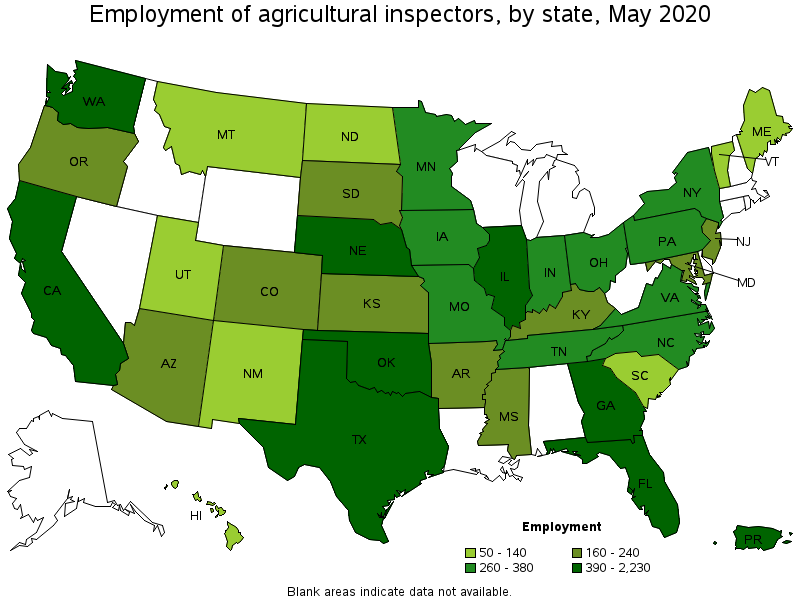
States with the highest employment level in Agricultural Inspectors:
| State | Employment (1) | Employment per thousand jobs | Location quotient (9) | Hourly mean wage | Annual mean wage (2) |
|---|---|---|---|---|---|
| California | 2,230 | 0.14 | 1.40 | $ 23.90 | $ 49,720 |
| Texas | 890 | 0.07 | 0.76 | $ 27.85 | $ 57,930 |
| Washington | 660 | 0.21 | 2.13 | $ 21.68 | $ 45,090 |
| Georgia | 520 | 0.12 | 1.25 | $ 20.48 | $ 42,590 |
| Illinois | 500 | 0.09 | 0.91 | $ 27.17 | $ 56,520 |
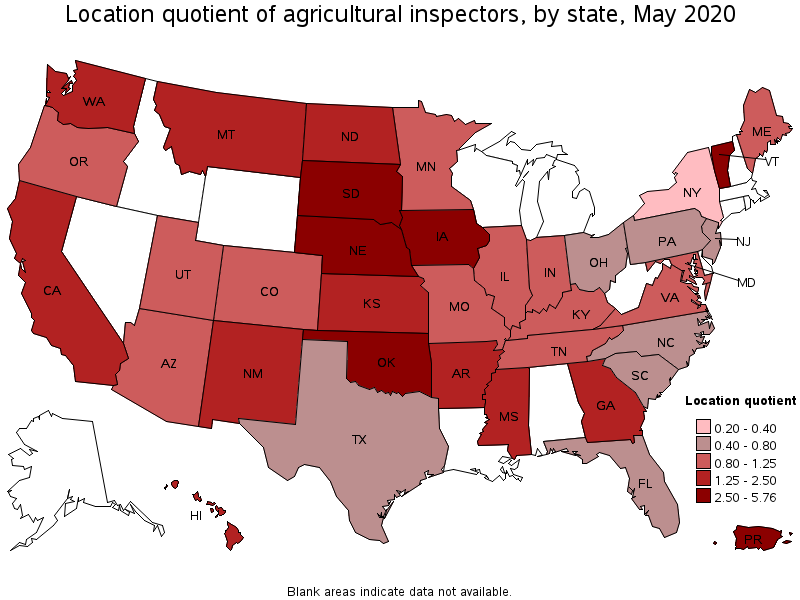
States with the highest concentration of jobs and location quotients in Agricultural Inspectors:
| State | Employment (1) | Employment per thousand jobs | Location quotient (9) | Hourly mean wage | Annual mean wage (2) |
|---|---|---|---|---|---|
| Nebraska | 390 | 0.42 | 4.29 | $ 21.84 | $ 45,420 |
| South Dakota | 170 | 0.41 | 4.24 | $ 17.48 | $ 36,360 |
| Iowa | 380 | 0.26 | 2.68 | $ 25.20 | $ 52,420 |
| Vermont | 70 | 0.25 | 2.62 | $ 28.64 | $ 59,580 |
| Oklahoma | 390 | 0.25 | 2.55 | $ 20.22 | $ 42,060 |
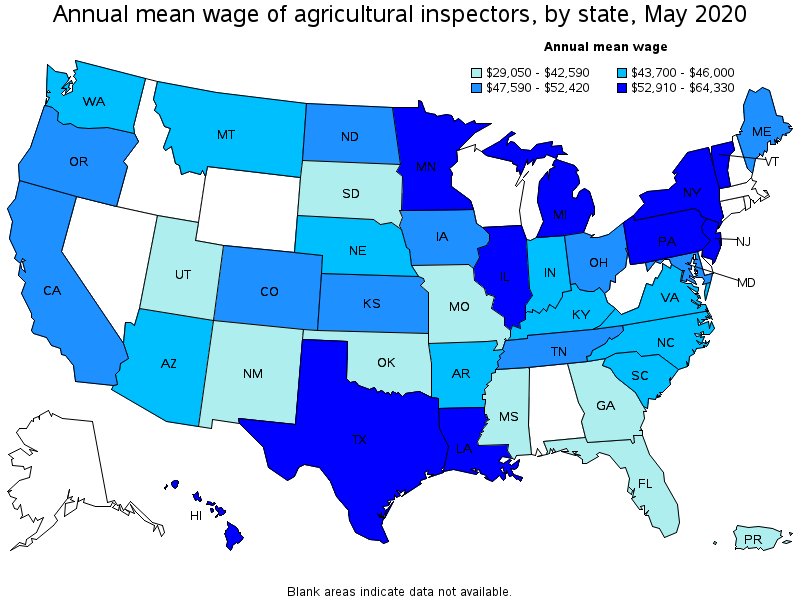
Top paying states for Agricultural Inspectors:
| State | Employment (1) | Employment per thousand jobs | Location quotient (9) | Hourly mean wage | Annual mean wage (2) |
|---|---|---|---|---|---|
| New York | 310 | 0.04 | 0.37 | $ 30.93 | $ 64,330 |
| New Jersey | 190 | 0.05 | 0.52 | $ 30.33 | $ 63,090 |
| Minnesota | 280 | 0.10 | 1.05 | $ 28.75 | $ 59,800 |
| Vermont | 70 | 0.25 | 2.62 | $ 28.64 | $ 59,580 |
| Michigan | (8) | (8) | (8) | $ 28.16 | $ 58,580 |
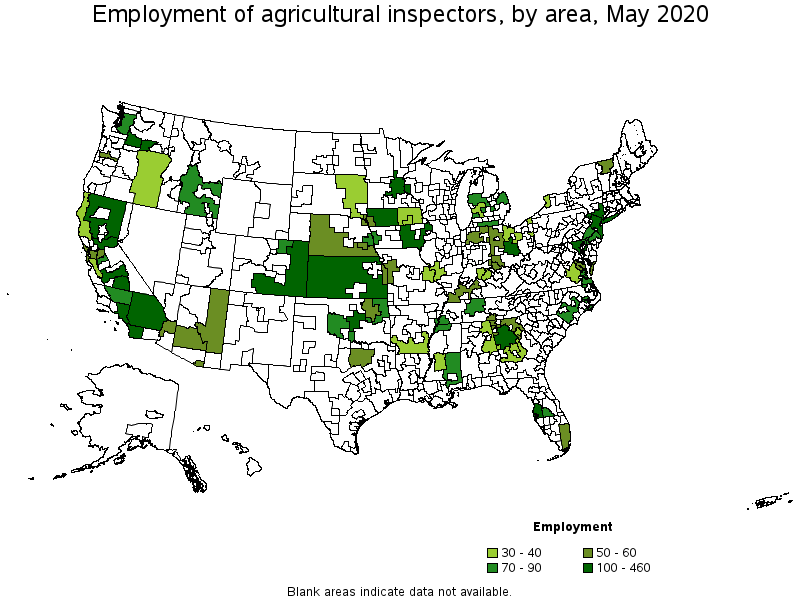
Metropolitan areas with the highest employment level in Agricultural Inspectors:
| Metropolitan area | Employment (1) | Employment per thousand jobs | Location quotient (9) | Hourly mean wage | Annual mean wage (2) |
|---|---|---|---|---|---|
| Los Angeles-Long Beach-Anaheim, CA | 460 | 0.08 | 0.81 | $ 25.95 | $ 53,970 |
| Fresno, CA | 300 | 0.80 | 8.22 | $ 23.64 | $ 49,160 |
| New York-Newark-Jersey City, NY-NJ-PA | 300 | 0.03 | 0.35 | $ 31.60 | $ 65,740 |
| Riverside-San Bernardino-Ontario, CA | 250 | 0.17 | 1.73 | $ 19.37 | $ 40,290 |
| Kennewick-Richland, WA | 230 | 2.06 | 21.27 | $ 15.99 | $ 33,260 |
| Sacramento--Roseville--Arden-Arcade, CA | 180 | 0.19 | 1.91 | $ 19.34 | $ 40,230 |
| Atlanta-Sandy Springs-Roswell, GA | 160 | 0.06 | 0.64 | $ 19.90 | $ 41,380 |
| Minneapolis-St. Paul-Bloomington, MN-WI | 160 | 0.09 | 0.91 | $ 32.05 | $ 66,660 |
| Baltimore-Columbia-Towson, MD | 160 | 0.12 | 1.29 | $ 23.09 | $ 48,020 |
| Oklahoma City, OK | 130 | 0.21 | 2.18 | $ 20.45 | $ 42,530 |
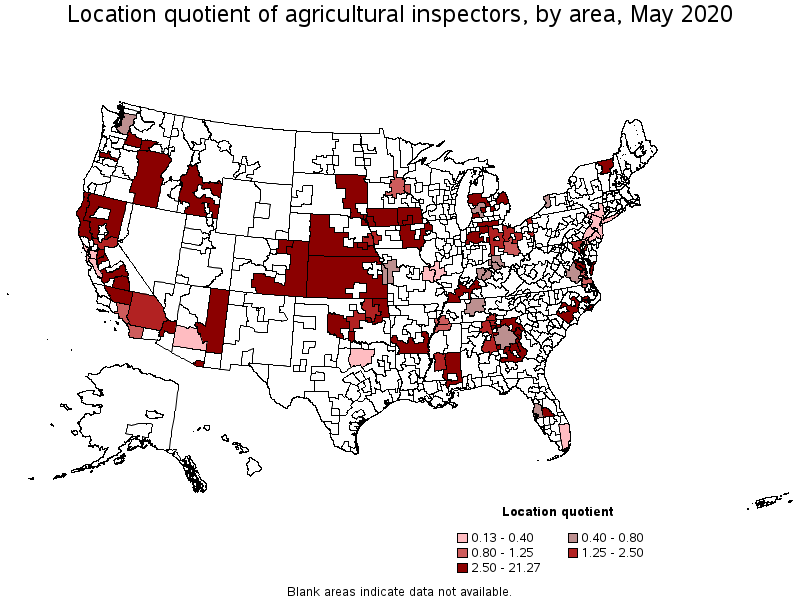
Metropolitan areas with the highest concentration of jobs and location quotients in Agricultural Inspectors:
| Metropolitan area | Employment (1) | Employment per thousand jobs | Location quotient (9) | Hourly mean wage | Annual mean wage (2) |
|---|---|---|---|---|---|
| Kennewick-Richland, WA | 230 | 2.06 | 21.27 | $ 15.99 | $ 33,260 |
| Yakima, WA | 120 | 1.33 | 13.70 | $ 24.08 | $ 50,090 |
| Fresno, CA | 300 | 0.80 | 8.22 | $ 23.64 | $ 49,160 |
| Sioux City, IA-NE-SD | 60 | 0.79 | 8.18 | $ 23.11 | $ 48,070 |
| Visalia-Porterville, CA | 100 | 0.69 | 7.17 | $ 29.80 | $ 61,980 |
| Greeley, CO | 70 | 0.68 | 6.99 | (8) | (8) |
| Modesto, CA | 80 | 0.47 | 4.85 | $ 19.03 | $ 39,570 |
| Athens-Clarke County, GA | 40 | 0.45 | 4.64 | $ 23.97 | $ 49,860 |
| Waterloo-Cedar Falls, IA | 30 | 0.42 | 4.30 | $ 24.29 | $ 50,530 |
| Macon, GA | 40 | 0.41 | 4.28 | $ 19.49 | $ 40,550 |
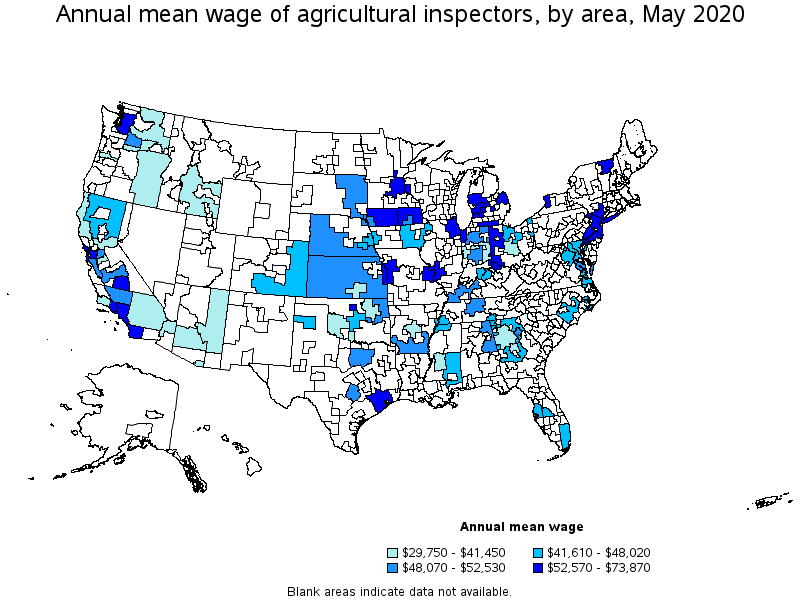
Top paying metropolitan areas for Agricultural Inspectors:
| Metropolitan area | Employment (1) | Employment per thousand jobs | Location quotient (9) | Hourly mean wage | Annual mean wage (2) |
|---|---|---|---|---|---|
| San Francisco-Oakland-Hayward, CA | 50 | 0.02 | 0.24 | $ 35.51 | $ 73,870 |
| Houston-The Woodlands-Sugar Land, TX | (8) | (8) | (8) | $ 33.33 | $ 69,330 |
| Minneapolis-St. Paul-Bloomington, MN-WI | 160 | 0.09 | 0.91 | $ 32.05 | $ 66,660 |
| New York-Newark-Jersey City, NY-NJ-PA | 300 | 0.03 | 0.35 | $ 31.60 | $ 65,740 |
| Seattle-Tacoma-Bellevue, WA | 80 | 0.04 | 0.40 | $ 30.63 | $ 63,710 |
| Chicago-Naperville-Elgin, IL-IN-WI | (8) | (8) | (8) | $ 29.87 | $ 62,120 |
| Visalia-Porterville, CA | 100 | 0.69 | 7.17 | $ 29.80 | $ 61,980 |
| Grand Rapids-Wyoming, MI | 30 | 0.07 | 0.69 | $ 29.32 | $ 60,980 |
| Enid, OK | (8) | (8) | (8) | $ 29.24 | $ 60,820 |
| Oxnard-Thousand Oaks-Ventura, CA | (8) | (8) | (8) | $ 27.91 | $ 58,050 |
Nonmetropolitan areas with the highest employment in Agricultural Inspectors:
| Nonmetropolitan area | Employment (1) | Employment per thousand jobs | Location quotient (9) | Hourly mean wage | Annual mean wage (2) |
|---|---|---|---|---|---|
| Kansas nonmetropolitan area | 180 | 0.49 | 5.01 | $ 23.68 | $ 49,260 |
| Southeast Iowa nonmetropolitan area | 120 | 0.58 | 5.95 | $ 22.02 | $ 45,790 |
| North Valley-Northern Mountains Region of California nonmetropolitan area | 120 | 1.21 | 12.54 | $ 20.98 | $ 43,640 |
| Eastern and Southern Colorado nonmetropolitan area | 100 | 1.54 | 15.89 | $ 20.67 | $ 43,000 |
| Northwest Iowa nonmetropolitan area | 100 | 0.73 | 7.58 | $ 27.84 | $ 57,900 |
Nonmetropolitan areas with the highest concentration of jobs and location quotients in Agricultural Inspectors:
| Nonmetropolitan area | Employment (1) | Employment per thousand jobs | Location quotient (9) | Hourly mean wage | Annual mean wage (2) |
|---|---|---|---|---|---|
| Eastern and Southern Colorado nonmetropolitan area | 100 | 1.54 | 15.89 | $ 20.67 | $ 43,000 |
| North Valley-Northern Mountains Region of California nonmetropolitan area | 120 | 1.21 | 12.54 | $ 20.98 | $ 43,640 |
| Southwest Oklahoma nonmetropolitan area | 70 | 1.17 | 12.11 | $ 14.30 | $ 29,750 |
| Northeast Virginia nonmetropolitan area | 50 | 0.99 | 10.20 | $ 23.18 | $ 48,220 |
| Southeast-Central Idaho nonmetropolitan area | 70 | 0.86 | 8.87 | $ 17.08 | $ 35,530 |
Top paying nonmetropolitan areas for Agricultural Inspectors:
| Nonmetropolitan area | Employment (1) | Employment per thousand jobs | Location quotient (9) | Hourly mean wage | Annual mean wage (2) |
|---|---|---|---|---|---|
| Balance of Lower Peninsula of Michigan nonmetropolitan area | 70 | 0.27 | 2.81 | $ 29.26 | $ 60,860 |
| Northern Vermont nonmetropolitan area | 50 | 0.73 | 7.55 | $ 28.86 | $ 60,030 |
| West Northwestern Ohio nonmetropolitan area | 50 | 0.20 | 2.11 | $ 27.96 | $ 58,160 |
| Northwest Iowa nonmetropolitan area | 100 | 0.73 | 7.58 | $ 27.84 | $ 57,900 |
| Northeast Iowa nonmetropolitan area | 40 | 0.37 | 3.86 | $ 26.98 | $ 56,120 |
These estimates are calculated with data collected from employers in all industry sectors, all metropolitan and nonmetropolitan areas, and all states and the District of Columbia. The top employment and wage figures are provided above. The complete list is available in the downloadable XLS files.
The percentile wage estimate is the value of a wage below which a certain percent of workers fall. The median wage is the 50th percentile wage estimate—50 percent of workers earn less than the median and 50 percent of workers earn more than the median. More about percentile wages.
(1) Estimates for detailed occupations do not sum to the totals because the totals include occupations not shown separately. Estimates do not include self-employed workers.
(2) Annual wages have been calculated by multiplying the hourly mean wage by a "year-round, full-time" hours figure of 2,080 hours; for those occupations where there is not an hourly wage published, the annual wage has been directly calculated from the reported survey data.
(3) The relative standard error (RSE) is a measure of the reliability of a survey statistic. The smaller the relative standard error, the more precise the estimate.
(7) The value is less than .005 percent of industry employment.
(8) Estimate not released.
(9) The location quotient is the ratio of the area concentration of occupational employment to the national average concentration. A location quotient greater than one indicates the occupation has a higher share of employment than average, and a location quotient less than one indicates the occupation is less prevalent in the area than average.
Other OEWS estimates and related information:
May 2020 National Occupational Employment and Wage Estimates
May 2020 State Occupational Employment and Wage Estimates
May 2020 Metropolitan and Nonmetropolitan Area Occupational Employment and Wage Estimates
May 2020 National Industry-Specific Occupational Employment and Wage Estimates
Last Modified Date: March 31, 2021